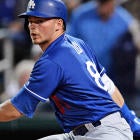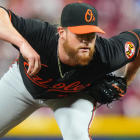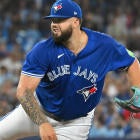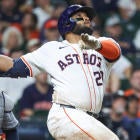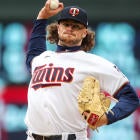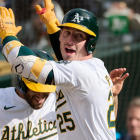Normally, top prospects aren't traded for 33-year-old relief rentals with no track record to speak of, which makes it fair to wonder if Kolby Allard, shipped to the Rangers for Chris Martin last week, still qualifies.
But then, he's not your typical prospect. Hasn't been for a while, actually.
Getting drafted 14th overall in 2015 of course gave him a leg up in the prospect rankings, and as recently as last year, MLB.com, Baseball America and Baseball Prospectus all had him in their preseason top 100 (the latter ranking him as high as 24th). It was about that time, though, that the scouting reports took on a more negative tone, making it seem like his high ranking was mostly a matter of him being grandfathered in by his initial prospect standing.
His breaking ball had regressed. His fastball hadn't improved as hoped. He was sitting in the high 80s/low 90s, which while survivable against lesser hitters makes for the sort of mushiness that ... well, that we saw in his three big-league appearances last year, when he put together a 12.38 ERA.
| ||||||||||
Yeah, no prospect publication had him anywhere near its top 100 this spring. And yet ...
It all seems a little unfair for a 21-year-old, right? The Braves moved him aggressively, ensuring he was always one of the youngest players at his level, and normally, we wouldn't consider anyone his age to be fully developed physically.
And then there's the small matter of him actually pitching well at every minor-league stop. Last year, he finished with a 2.72 ERA and 1.21 WHIP, all at Triple-A. His 7.1 K/9 raised concerns given the necessity of strikeouts in today's game, but he's up to 8.3 K/9 at Triple-A this year. Sure, it goes along with a 3.99 ERA and 1.40 WHIP, both of which might seem like a significant step back, but the introduction of juiced balls to the Triple-A level this year has made for a hellish environment for pitchers, with few of the top-flight pitching prospects performing up to expectations.
Plus, Allard's numbers have taken a sharp turn for the better over his past 10 starts, during which he has put together a 3.41 ERA, 1.28 WHIP and 9.9 K/9. Those numbers include his one only start for the Rangers organization in which he struck out eight over five shutout innings.
"I think this is [the most confident I've been] in my career," Allard told the Fort Worth Star-Telegram prior to that start, "just in the sense of knowing who I am as a pitcher and knowing what I want to do, how I want to attack guys and how I want to navigate through lineups."
It helps that more recent radar readings have his fastball peaking at 94 mph. Between that and the development of a cutter to flesh out his arsenal, there may be something to salvage here yet.
Allard's debut with the Rangers, which is scheduled for Friday, understandably hasn't met with much fanfare, but it's a start to keep stock of in a year when we're often straining to find upside at starting pitcher.
Five on the verge
(These are the prospects most worth stashing in redraft leagues.)
Gavin Lux, SS, Dodgers
2018 minors: .324 BA (463 AB), 15 HR, 13 SB, .913 OPS, 57 BB, 88 K
2019 minors: .362 BA (390 AB), 23 HR, 9 SB, 1.065 OPS, 51 BB, 86 K
We have a new No. 1, which of course means this is the week Kyle Tucker gets called up. But no, my feelings on the subject of Lux's promotion have gone from "eh ... maybe" to "oh, it's happening" with the news of Alex Verdugo straining his oblique. The Dodgers had seemingly already paved the way for Lux by announcing they would no longer play Joc Pederson at first base, which seemed like a precursor to them moving the slumping platoon bat out of the lineup altogether and shifting Max Muncy from second base to first. Now, they have room for Pederson and Lux both.
No, they didn't immediately call up Lux, because it's never that easy, but once the but-where-would-we-play-him? excuse is off the table, a team with World Series aspirations can only ignore the kinds of things Lux is doing at Triple-A -- a .458 batting average with 10 home runs, a 1.394 OPS and nearly as many walks (23) as strikeouts (26) -- for so long. Here's what president of baseball operations Andrew Friedman had to say on the matter, according to AM 570 LA Sports:
"From our standpoint with young players, if there is an opportunity to play every day, and its what's right for their development, we make those moves. And when it's not, then we wait a little bit. But this is a guy that I feel like will really impact us next year, but I wouldn't rule out the possibility of it being this year."
If they're looking to raise the trophy this year, Lux could be a big part of what finally accomplishes it.
Kyle Tucker, OF, Astros
2018 minors: .332 BA (407 AB), 24 HR, 20 SB, .989 OPS, 48 BB, 84 K
2019 minors: .268 BA (388 AB), 30 HR, 24 SB, .925 OPS, 46 BB, 101 K
With Tyler White, Tony Kemp and Derek Fisher all discarded at or near the trade deadline, there are fewer bodies blocking Tucker's ascent to the big leagues, but there's no actual opening yet. Still, now more than ever, the one-injury-away trope applies, especially now that he's coming out of his July slump, batting .417 (10 for 24) with three home runs and a stolen base so far in August. The wait has been a long and frustrating one, but the fact the Astros didn't move him at the deadline despite widespread interest shows that they still consider him a big part of their future.
Luis Robert, OF, White Sox
2018 minors: .269 BA (186 AB), 0 HR, 11 2B, 15 SB, .694 OPS, 12 BB, 52 K
2019 minors: .341 BA (402 AB), 23 HR, 34 SB, 1.016 OPS, 23 BB, 98 K
To the extent it can apply to a baseball player, Robert is a human highlight reel, delivering stunning feats on a near-nightly basis. He could stand to be more disciplined at the plate, perhaps, but it's difficult to criticize when he's keeping his strikeouts in check. He has nothing more to prove in the minors, really, so it comes down to whether the White Sox are willing to sacrifice some financial wiggle room in order to assess his readiness for next year -- a season that should represent a major turning point in their rebuild. I'd put the chances at less than 50/50, but the potential impact is so considerable that you should probably be stashing him anyway.
Justus Sheffield, SP, Mariners
2018 minors: 7-6, 2.48 ERA, 1.14 WHIP, 116 IP, 50 BB, 123 K
2019 minors: 7-8, 3.93 ERA, 1.37 WHIP, 121 1/3 IP, 55 BB, 119 K
We still don't know who's going to replace Mike Leake in the Mariners rotation -- a surplus of off days has allowed them to take their sweet time announcing it -- but there's still no more deserving candidate than Sheffield, who turned in another gem for Double-A Arkansas on Tuesday. He struck out six while walking none over six shutout innings, bringing his ERA to 1.49 in 10 starts at that level. The 9.6 K/9 is to be expected, but the 1.9 BB/9 for a guy with a history of control issues is obviously a step in the right direction. Subjecting him to Triple-A Tacoma and all of its juiced-ball madness again would probably be a step in the wrong direction, and the fact they haven't yet suggests the Mariners know it.
Jo Adell, OF, Angels
2018 minors: .290 BA (396 AB), 20 HR, 15 SB, .897 OPS, 32 BB, 111 K
2019 minors: .301 BA (209 AB), 10 HR, 6 2B, .909 OPS, 24 BB, 61 K
Adell just got moved up to Triple-A a week ago. He's all of 20 years old. The Angels have no opening with Mike Trout, Justin Upton and Kole Calhoun occupying the outfield and Shohei Ohtani locked in at DH. And yet I can't help but feel like this is the sort of team that would give Adell a late look in the majors simply because he deserved it. We haven't seen how they'd handle a prospect so precious since Mike Trout, and they had a different GM back then. Still, they've pretty much held to the let-the-performance-dictate standard with lesser talents.
"It's like [Angels general manager] Billy [Eppler] told me when I got drafted," Adell recently told the Deseret News, "the moment that you show you can handle a level, you move."
So far, Adell has handled Triple-A with the same ease as any other level. It's obviously too early to judge, but by the end of the month, it may not be. And since Calhoun is likely headed to free agency this offseason, the Angels aren't beholden to him when there's nothing to play for.
Five on the periphery
(These are some other prospects doing something of note.)
Jesus Luzardo, SP, Athletics
2018 minors: 10-5, 2.88 ERA, 1.09 WHIP, 109 1/3 IP, 30 BB, 129 K
2019 minors: 2-0, 2.53 ERA, 0.94 WHIP, 21 1/3 IP, 2 BB, 30 K
Luzardo, who has been out since spring training with a strained rotator cuff, has begun a second rehab assignment after having his initial one interrupted by a strained lat. A month ago, he was on the verge of returning. Now, he's striking out five over two shutout innings in Rookie ball. It's a fairly quick turnaround for what sometimes can be a serious injury, and the Athletics probably wouldn't rehab him so aggressively if they didn't think he could impact the wild card race down the stretch. He probably won't need as many rehab starts as the first time around, but there's no rush to add him just yet. Otherwise, he'd be in my Five on the Verge.
Ty France, 3B, Padres
2018 minors: .267 BA (509 AB), 22 HR, 30 2B, .819 OPS, 46 BB, 89 K
2019 minors: .399 BA (276 AB), 26 HR, 24 2B, 1.252 OPS, 26 BB, 48 K
Ty France has looked more like Ty Cobb at Triple-A this year, leading all minor leaguers (A-ball or higher) in batting average and ranking second only to Kevin Cron in OPS. The 26 homers is a mark he's achieved even while losing six weeks to a major-league stint in which he wasn't getting consistent playing time. He's a 25-year-old non-prospect who may simply be taking advantage of a juiced ball in a hitter-friendly environment, yet no one else in that environment is doing quite what he's doing. Even the strikeout rate is shockingly low.
Though he did underwhelm in his first major-league showing, figuring out how to fit him in the lineup is probably the bigger reason he hasn't gotten a second look yet, but it's worth noting he has started four straight at second base while Luis Urias continues to flounder at the big-league level. Could the Padres pull the ol' switcheroo?
Randy Arozarena, OF, Cardinals
2018 minors: .274 BA (358 AB), 12 HR, 26 SB, .792 OPS, 34 BB, 84 K
2019 minors: .350 BA (286 AB), 9 HR, 15 SB, .981 OPS, 31 BB, 60 K
Speaking of guys in their mid-20s doing seemingly impossible things in the whacked out environment of Triple-A, Arozarena is the Cardinals' version. His numbers aren't quite as eye-popping as France's, but mostly because no one's can be. Right down to the strikeout rate, which shouldn't at all be influenced by the environment, he too is thriving, but as with France, we've heard few rumblings of his impending arrival. Prior to this season, Arozarena projected as more of a fourth outfielder in the majors, and there may be some skepticism surrounding his breakthrough given what's happened at Triple-A and in the PCL specifically. But there are a number of skills for him to work with here, such as a gap-to-gap approach, good plate discipline and plus (if sometimes reckless) speed.
Joe Ryan, SP, Rays
2018 minors: 2-1, 3.72 ERA, 1.10 WHIP, 36 1/3 IP, 14 BB, 51 K
2019 minors: 9-4, 1.79 ERA, 0.81 WHIP, 110 1/3 IP, 23 BB, 159 K
Despite delivering one of the more stunning statistical performances from a minor-league pitcher this year, Ryan hasn't gotten much attention as a 23-year-old still toiling at A-ball (albeit high A). But he was only drafted a year ago and will presumably get a taste of Double-A by season's end. His numbers at this latest stop have been particularly unreal -- a 1.42 ERA, 0.71 WHIP and 12.2 K/9 in 15 appearances -- and Wednesday's one-hit, 13-strikeout effort could be what finally moves him up the ladder. His fastball has picked up a couple miles per hour this year, and he combines it with a slow curveball to great effect. He'll need to develop a third pitch soon, though, given his age.
Seth Corry, SP, Giants
2018 minors: 4-3, 3.59 ERA, 1.46 WHIP, 57 2/3 IP, 32 BB, 59 K
2019 minors: 9-2, 1.72 ERA, 1.04 WHIP, 99 1/3 IP, 48 BB, 136 K
Corry is right there with Ryan in terms of eye-popping statistical performances, and his has found another gear lately. Equipped with a live fastball and a plus curveball that should make him a big strikeout guy at every stop in the minors, the biggest knock on him coming into the year was his shaky control, but he appears to have whipped it over his past eight starts, issuing 1.6 BB/9. His ERA during that stretch: 0.79. The 20-year-old has a long way to climb, obviously, but he deserves to be on dynasty leaguers' radar.















